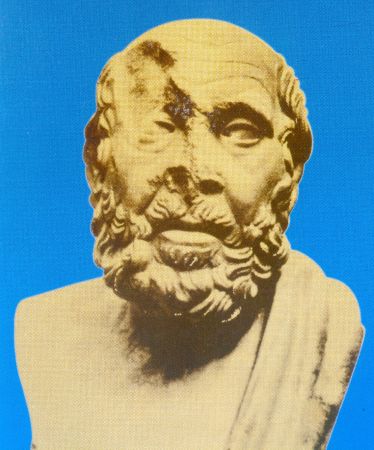The island has had several names. Thucydides and Strabo called it Kos Meropis, Pliny Nymphaea, and Stephanos of Byzantium Karis. In the Middle Ages it was known as Lango, perhaps because of its length, and later as Stanchio, a corruption of "stin Ko", whence Turkish Istanköy. Kos was inhabited in neolithic times, as is proved by discoveries in the Cave of Aspropetro, near Kephalos. It was colonized by Carians and, in the Homeric age, by Dorians from Epidauros. In the Persian wars it was under the sway of Artemisia, queen of Caria, and so fought on the losing side. Kos was at first a member of the Dorian hexapolis and of little importance. Its city (later remembered as Astypalaia, "old city") was situated in the south-west of the island. Here Hippocrates, the greatest physician of antiquity, was born in the mid-5th century BC. The city was destroyed by the Lacedaemonians in the Peloponnesian war. The new city of Kos was founded in 366 BC and rapidly prospered to become one of the greatest maritime centres of the Aegean. Its sanctuary of Asklepios and school of medicine made it famous all over the ancient world.
Kos was occupied by Alexander the Great in 336 BC, and on his death in 323 passed to the Ptolemies. Ptolemy II Philadelphos was born on the island in 309. Cleopatra is said to have used the island as a store for some of her treasures. Later Kos was allied to Rome before becoming part of the pro-consular Province of Asia. The city was adorned with a plethora of artistic monuments. Its wines and silks had a great reputation; the light silk dresses called Coae vestes were well known to the Romans for their transparency. In the Byzantine era Kos was the seat of a bishop and many early Christian basilicas (5th-6th century) have been uncovered. In the 11th century Kos was ravaged by Saracens. Later it passed to the Genoese, becoming in 1304 a fief of the Zaccharia family. Two years later it was ceded to the Knights of St. John, who did not take possession till 1315. The Knights made it into a strong-point. It was attacked by the Turks in 1457 and 1477, and fell to them, with Rhodes, in 1522. In 1912, after nearly four centuries of Turkish domination, it was occupied by the Italians in the course of their war with Turkey. In the Second World War British forces temporarily occupied the island.
After S. Rossiter, Blue Guide Greece, London 1977, p. 657.

Portrait. probably of Hippocrates.
It was found in the tomb of a Greek doctor (C. Marcius Demetrius) near Ostia-Portus.
From: M.S. Kiapokas, Hippocrates of Cos and the Hippocratic Oath, Athens 1999, p. 68.